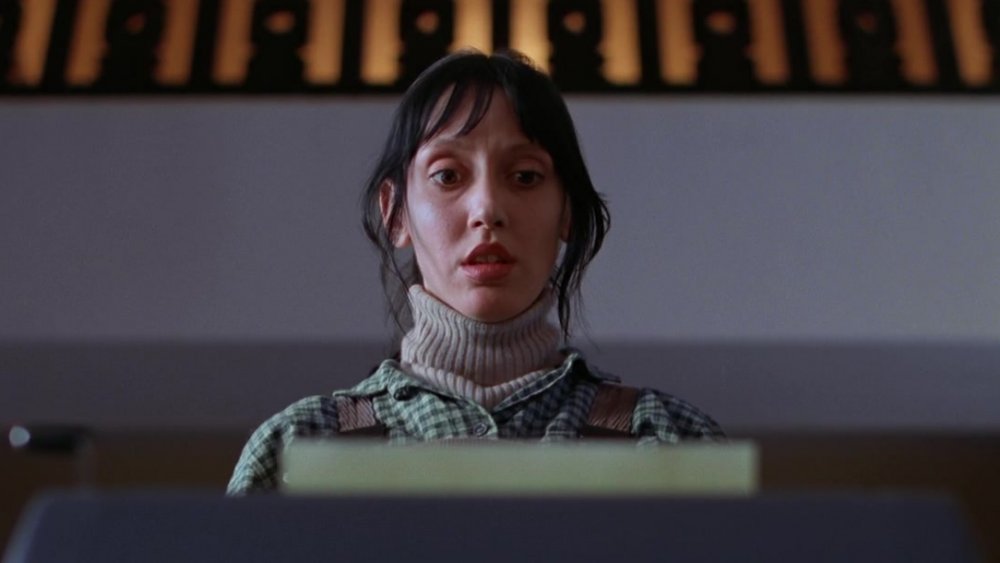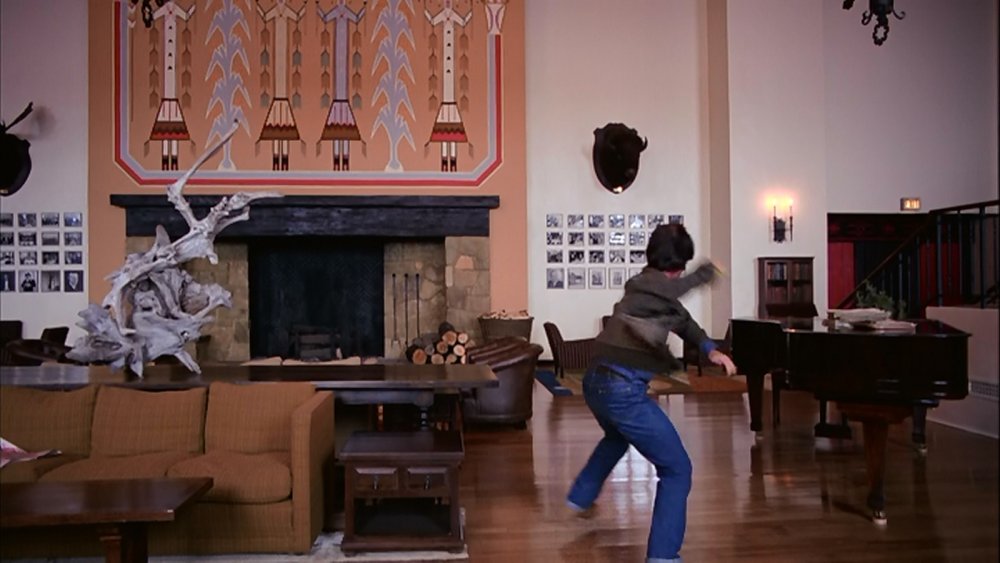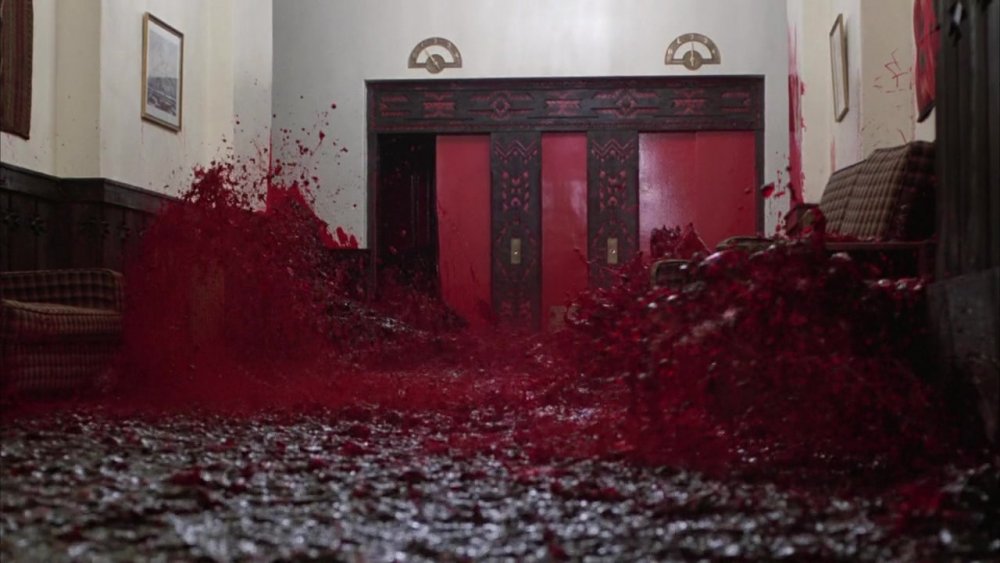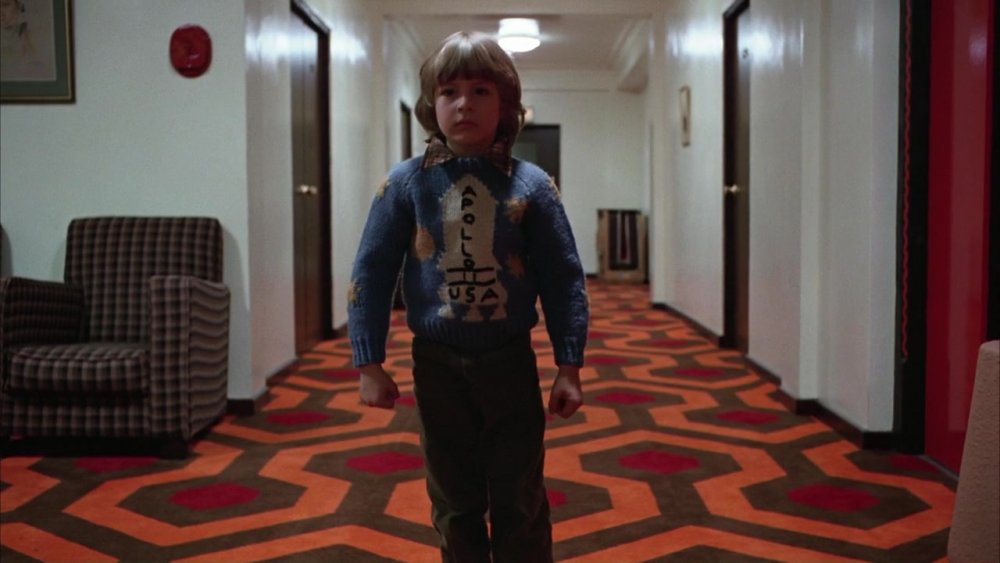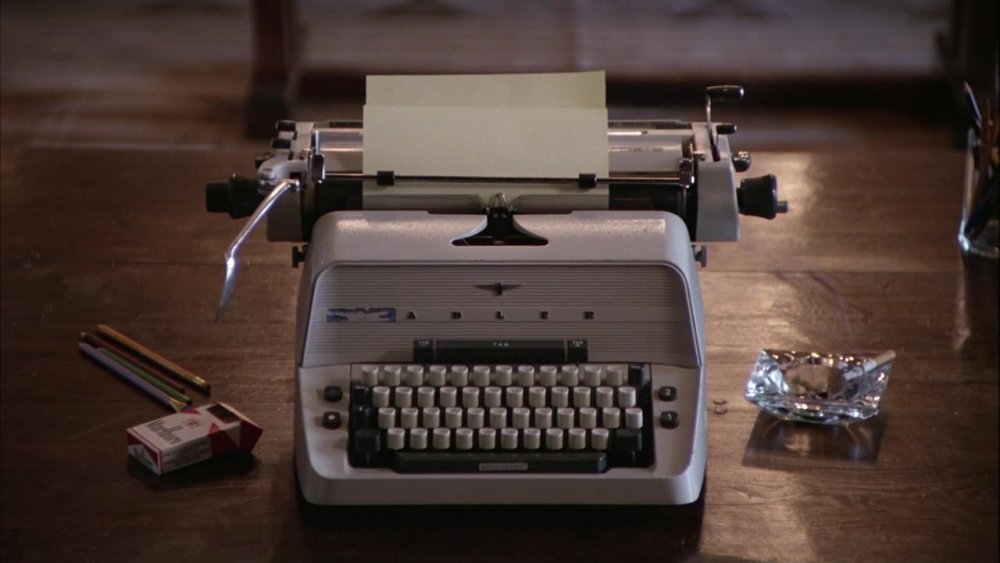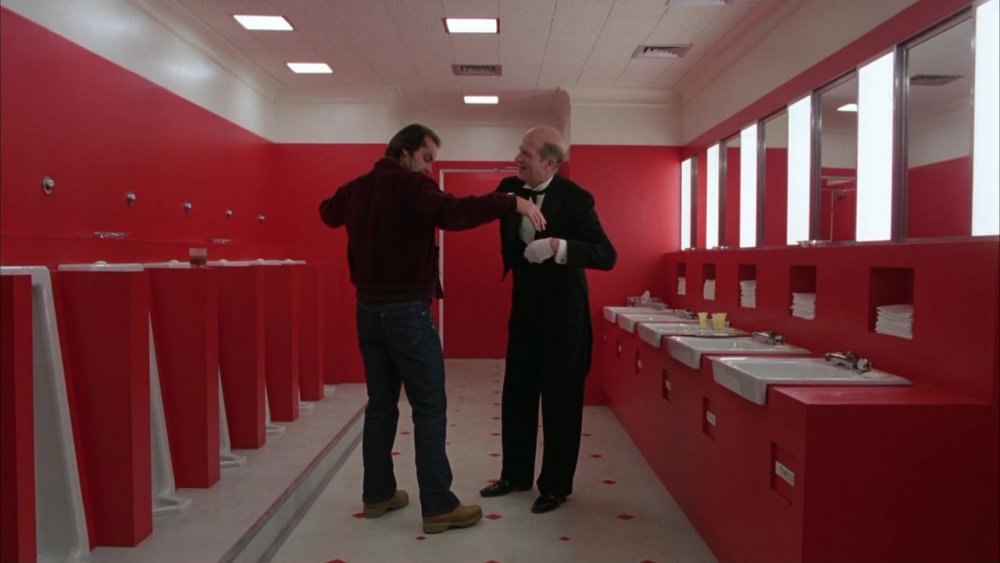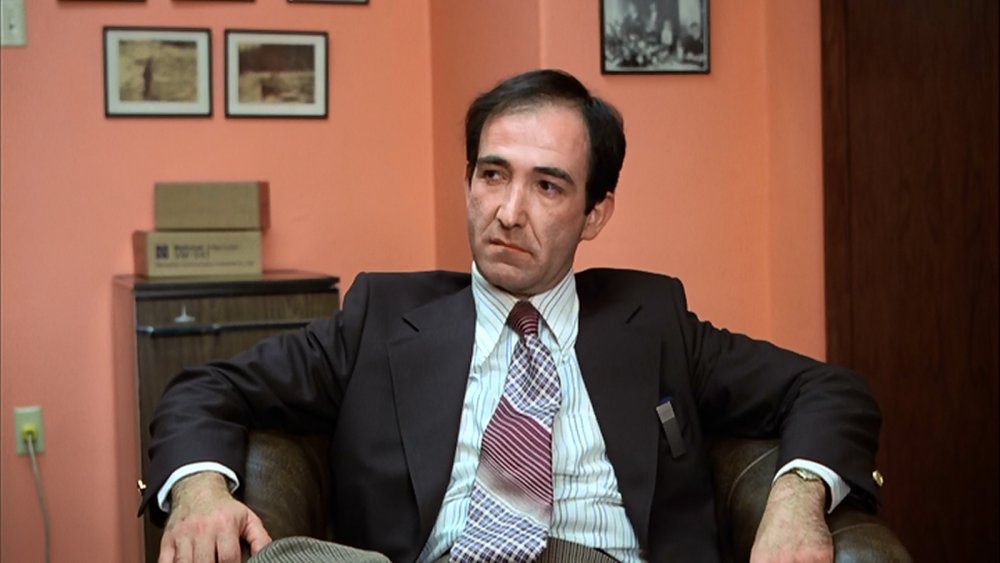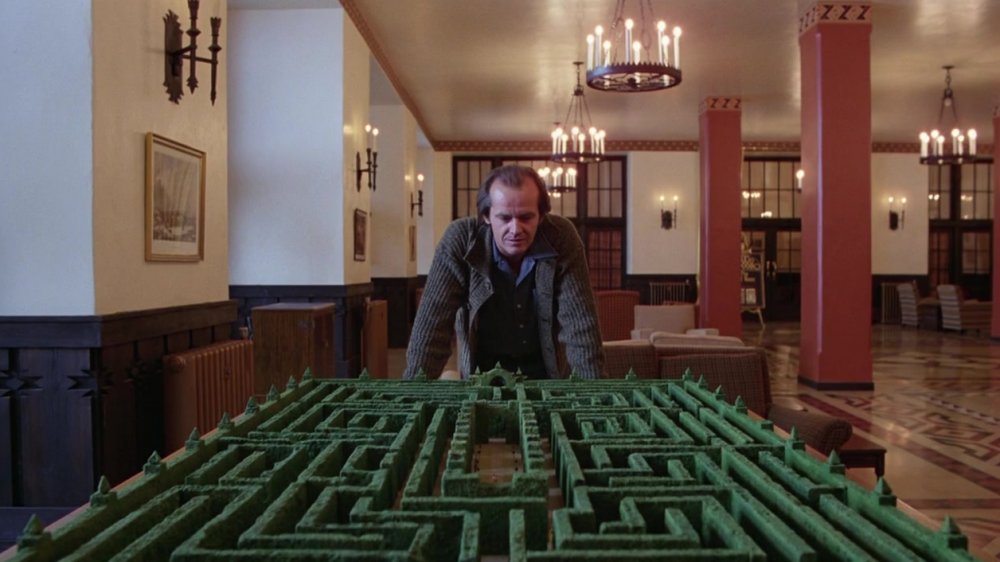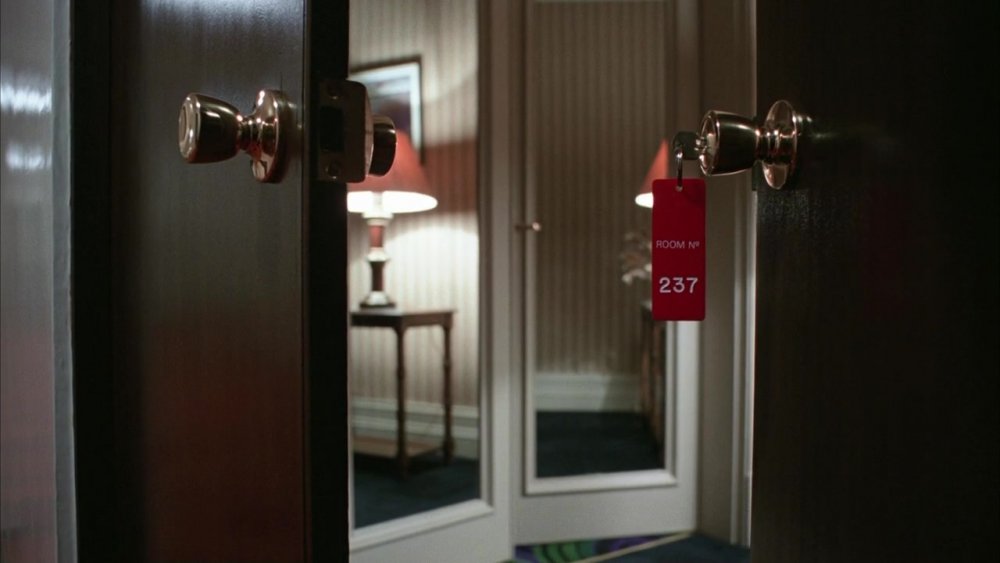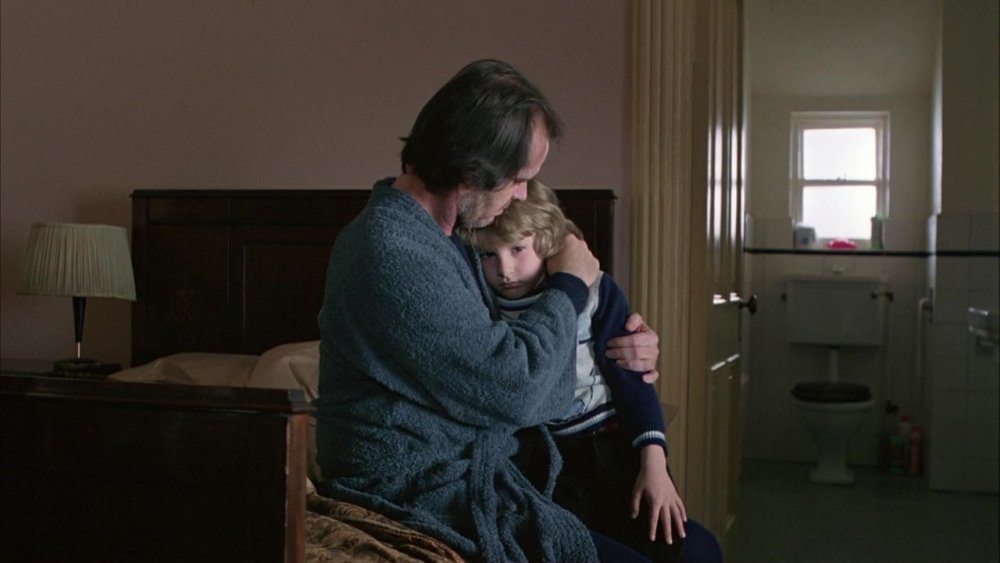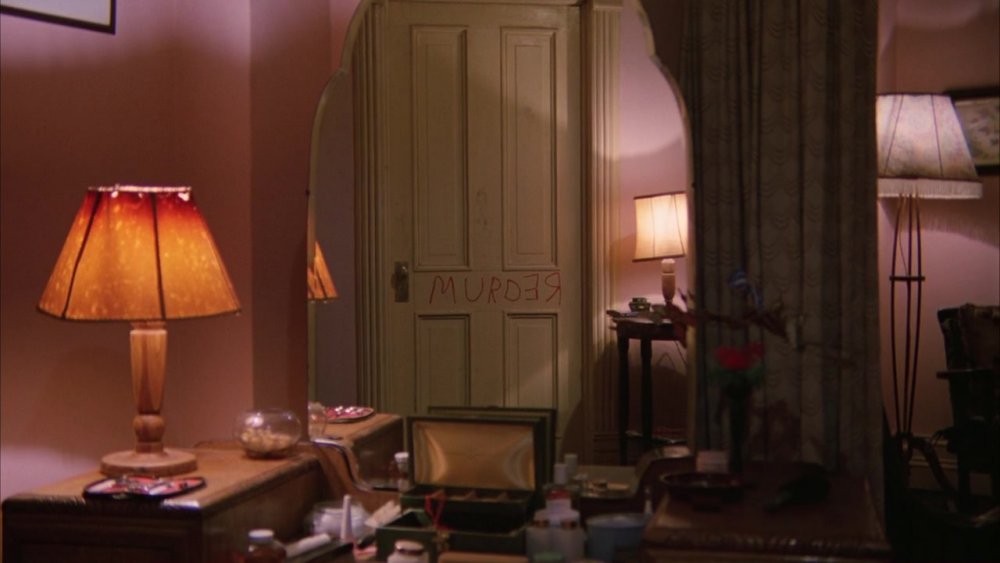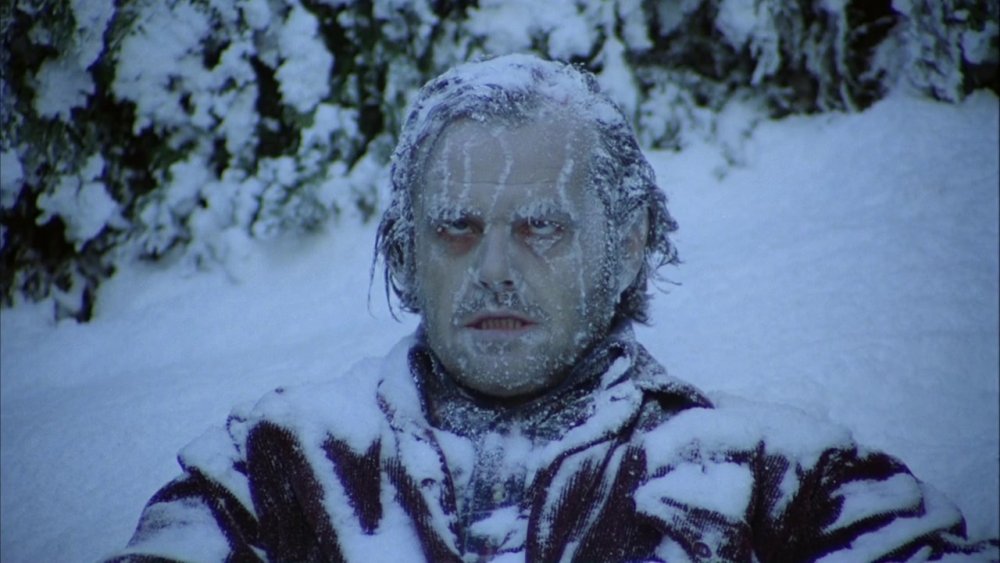Fan Theories About The Shining That Would Change Everything
Though initially released to middling reviews, few movies have stood the test of time quite like The Shining. This adaptation of Stephen King's novel is now not only regarded as among the best horror movies ever, but perhaps even more impressively, one of Stanley Kubrick's best movies.
On one hand, it's meticulously made, with every shot carefully choreographed and most scenes filmed dozens of times before Kubrick chose the perfect take. On the other hand, it's a total mess, full of hanging plot threads and incongruities. For both these reasons, The Shining has attracted an almost cult-like collective of fans who long to discover its secrets.
These amateur theorists have watched the film repeatedly, in slow motion, and even backwards, searching every frame for hidden meanings. Speculating about The Shining has proved to be such a rich vein that it's spawned a whole second movie, the fascinating documentary Room 237, which catalogs a wide array of fan theories that range from totally reasonable to the patently absurd and presents them all on equal footing.
What follows are our favorite fan theories we've gathered up from internet forums, fan films like Room 237, and just putting the movie on repeat until we start coming up with our own kooky headcanons. Some are surprisingly plausible, and they may change how you watch the film in the future. Others, however, are far sillier, just some fun "what ifs" to consider. After all, all work and no play makes Looper a dull website.
The Shining is about the genocide of Native Americans
Out of all the potential strange theories out there about the true meaning of The Shining, one of the more plausible ones is that the film is about the genocide of Native Americans by white settlers. The most overt hint occurs when Stuart Ullman — a man who dresses in red, white, and blue — explains that the Overlook was built on an Indian burial ground, but that's just the beginning of the story.
All throughout the hotel are depictions of Native Americans and Native American art motifs, such as the enormous sand painting on the wall of the Colorado Lounge Additionally, Jack uses the phrase "White Man's Burden," referring to the title of a poem by Rudyard Kipling which valorizes the colonization of natives by white imperialists, and Wendy's use of the phrase "keep American clean" is a clear reference to the "Keep America Beautiful" campaign from 1971, which famously features a crying Native American.
Internet film scholar Kevin McLeod, who did a commentary track for the home video release of Room 237, also claims that the film features a pair of hidden symbols from another group of indigenous Americans, the Maya. He asserts that in the iconic bright yellow film poster for The Shining, the extra wide letter "T" in the title is actually the Mayan symbol "Ik." And speaking of yellow, McLeod also claims a repeating pattern in the carpet of the Gold Room, a cross within a squares, is actually the Mayan symbol "K'an," the symbol for "yellow."
More proof for the Native American theory
Want more proof that The Shining is about the genocide of Native Americans? Well, there are numerous parallels between the film and the real life founding of Point Pleasant, West Virginia. This was a horrific, bloody event in which countless Native Americans were murdered, but perhaps the most famous Native person killed there was Hokolesqua, also known as Chief Cornstalk.
In 1777, Hokolesqua was living as a prisoner of the American military. One day, after a group of Native Americans attacked some US soldiers, those troops decided to enact mob justice against Hokolesqua, despite him having no involvement with the attack. Legend states that Hokolesqua's final words were, "May the curse of the Great Spirit rest upon this land. May it be blighted by nature. May it even be blighted in its hopes. May the strength of its peoples be paralyzed by the stain of our blood." This statement has clear parallels to the famous wave of blood from the film, but believe it or not, it's not the biggest link between Point Pleasant and The Shining.
In 1909, the same year the fictional Overlook Hotel was completed, a real life monument to Point Pleasant was struck by a lightning, and it was believed by some that this was the spirit of Chief Cornstalk seeking revenge. Then, on July 4, 1921, this monument was struck by lightning again. And, as any true Shining fan knows, July 4, 1921, is the date on the old photograph of Jack from the final shot of the film.
Kubrick is confessing to staging the moon landing
Before we go any further, let's get one thing straight. The moon landing wasn't faked. The Mythbusters did a whole episode about it. Educate yourself. However, there has been a conspiracy theory circulating since before The Shining came out that the Apollo 11 moon landing was faked, and that Stanley Kubrick was the one hired by the government to shoot it. Could The Shining be Kubrick's covert confession?
Well, no ... but let's run down the evidence. In one scene, Danny is wearing a handmade sweater with a rocket and the words "Apollo 11" on it. There's Tang in the Overlook pantry, a product popularized through it's association with the space program. Also, during the adaptation from the book to the film, the most haunted room in the hotel changed room numbers, from 217 to 237, and the distance to the moon is about 237,000 miles away. (In truth, it's more like 238,900 miles away on average, but we didn't know this until the late '60s, so it's possible that Kubrick was looking at an old textbook, and thus got the number slightly wrong.)
Even if all of this is intentional, and Kubrick was really trying to allude to the Apollo 11 mission throughout the film, it's not necessarily evidence that he helped fake the moon landing. He was most likely aware of the conspiracy theory, and he also knew how closely people analyzed his films for hidden meanings. Maybe he decided to just mess with them a little.
The Shining is Kubrick's Holocaust film
Several times throughout his life, Kubrick tried to make a film about the Holocaust, but apparently, he never found a way to capture the sheer overwhelming scale of it. Though many claimed that films like Steven Spielberg's Schindler's List succeeded at this, Kubrick disagreed, saying, "The Holocaust is about 6 million people who get killed. Schindler's List is about 600 who don't." Even though Kubrick never tackled the Holocaust directly, maybe he did so indirectly when he made The Shining.
The opening helicopter shots make you feel like you're seeing the whole world at once, from a godlike scale. This sequence is accompanied by a chorus of wailing voices, the sound of millions suffering. The number 42 appears all throughout the film, such as on one of Danny's shirts, or when the Torrances watch the film Summer of '42, and 1942 was the year that the Nazis initiated the "Final Solution." Eagles, a symbol of the Nazi party, also appear throughout the Overlook. Even the brand of Jack's typewriter is "Adler," the German word for eagle.
One death is a tragedy, a million is a statistic. Maybe Kubrick realized that the only way to make us feel a worldwide tragedy was through showing us a single small one. The Shining ends by zooming in on one photo in a grid, then settling on Jack as one person in a large crowd. Seeing this, you feel that Jack's story is just one of many. One drop of blood in a crashing ocean.
The Overlook is Hell
One of the most subtly haunting elements of the Overlook Hotel is that its layout constantly seems to be shifting. The bright exterior window in Ullman's office is completely nonsensical, as his office is in the middle of the building. And during a conversation between Wendy and Jack in the Colorado Lounge, a chair in the background keeps appearing and disappearing again between shots. And when Hallorann is giving a tour to Wendy and Danny, they step into one giant cooler, but then exit from a different cooler across the room. Kubrick was a notoriously meticulous filmmaker, so it seems unlikely that these strange occurrences are just mistakes. What else might they signify?
Maybe Jack died long ago, and the Overlook is Hell, where he must continually repeat the last winter of his life forever. It's not that big of a stretch, as we already know the hotel has at least one other imprisoned murderous ghost in the form of Grady, who sometimes doesn't seem to remember killing his family. With this reading, many of the film's more puzzling lines suddenly become meaningful, like when Jack says, "When I came up here for my interview, it was as though I had been here before," or when Grady says to Jack, "You've always been the caretaker." Remember that unlike Wendy and Danny, Jack is never seen outside the Overlook or the road that leads up to it. Whenever you're watching The Shining, Jack is always the caretaker.
The Overlook is a CIA mind control experiment
There are a lot of continuity errors and geographical oddities in The Shining, but maybe that's because Jack and his family are hallucinating throughout their stay at the Overlook. In fact, maybe they're the subject of a government-run science experiment. According to this theory, Jack's employment at the Overlook is a front so that the US government can test out mind control techniques on isolated test subjects, and all the supernatural visions the Torrances experience are actually the results of these experiments.
It's a fun theory, but there's not much evidence to back it up, apart from a single incongruous poster in the game room. It's an image of a skier above the word "Monarch." However, during Jack's interview, Ullman claims that there's no skiing in the area. So what's "Monarch?" Well, according to conspiracy theorists, Monarch was the name of a real-world CIA project that attempted to discover the secrets of mind control.
In this reading of the film, the character Bill Watson, who seems like Stuart Ullman's assistant, is actually the brains of the operation, a high-ranking government agent. Notice that Watson is called into Ullman's office when Jack arrives, and yet he doesn't get a job title, and he doesn't ask Jack any questions. He just sits there, observing Jack's behavior suspiciously. Later, when Ullman tells Watson to transport some luggage, Watson seems annoyed, like he's not used to taking orders. And when Ullman gives Jack a tour, Watson trails behind, watching everything and saying nothing.
The Shining is a retelling of Theseus and the Minotaur
One unusual interpretation of The Shining is that it's actually a modern day retelling of the story of Theseus and the Minotaur. Just like the Minotaur has a labyrinth, the Overlook has a hedge maze. Danny escapes the maze by retracing his steps, similar to how Theseus escapes the labyrinth by following back a ball of twine that he'd been unwinding as he walked. Could this be a second meaning to the sign outside the Gold Room that advertises "the Unwinding Hours"?
At several points in the film, Jack stares into the distance with a lowered head, but with eyes pointed up, in the classic "Kubrick stare," a pose that is somewhat reminiscent of a bull. Additionally, in the strange skiing poster in the game room with the word "Monarch" on it, the skier is a silhouette with strange proportions. He has a large upper body, and he's hunched over, with small bent legs. It's a stretch, but if you're looking for Minotaur imagery, this certainly fits the bill. Maybe the "Monarch" in question is the Minotaur, who in Greek mythology was indeed from a royal bloodline.
One final detail that jives with this interpretation comes during the initial tour of the hotel. As the group is discussing royalty that has stayed at the Overlook, they pass a painting of a Native American wearing a buffalo headdress — a man with the head of a bull.
The Shining is about sexual abuse
Some of these theories are fun to talk about. Here's one that's a lot less fun. When Wendy discusses the time Jack injured Danny's arm, she's clearly afraid to discuss it directly. This enigmatic time period is also when Danny's imaginary friend Tony first appeared, which Danny's doctor implies could be a side effect of trauma. It's clear that something dark is happening between Jack and Danny Torrance, but just how dark is it?
Imagery of sex and sexual abuse is sprinkled all throughout in The Shining, and we're not just talking about the man in the dog costume. The boiler room is decorated with photos of naked women. When Jack enters the forbidden room 237, he has a sexual encounter that quickly turns very dark. We don't see what happens to Danny in room 237, but he comes out injured and deeply shaken. The film Room 237 also highlights a brief moment in which a paper tray on Ullman's desk looks like a massive erection. It's not not there, but it would certainly be an impressive feat of blocking and cinematography if this was intentional.
Strangest of all, when Jack is waiting to meet Ullman, he's reading Playgirl. Not only is this an unusual thing to read in public, if you find the actual issue pictured, one of the article names is "Incest: Why Parents Sleep With Their Children." None of this is conclusive evidence of anything, but it's all subtly pointing in the same direction.
The Shining is a revenge story, starring Danny
In Danny's discussion with Dick Hallorann, Dick claims that he isn't scared of anything in the Overlook, that it can't really hurt anyone. Most viewers think that he's trying to protect Danny from the truth, but what if this is the truth? What if the ghosts of the Overlook are "just like pictures in a book"? What if the real thing that kills Jack is Danny?
We know Danny has the motive. Though we don't know the extent of it, Jack has certainly been abusing him in some way. He also has the means. Danny has psychic powers, and it's not unreasonable to think that if he wanted to get rid of his dad, maybe he'd manipulate Jack's mind, pushing him towards another violent episode, so that Wendy would finally leave him.
There's just one problem. Wendy is hopelessly devoted to Jack, so first, he needs to break her of that loyalty. That could be why Danny summons Dick Hallorann to the hotel, so that Jack can kill him. He's a necessary sacrifice to definitively prove that Jack is beyond saving, and thus, they need to leave him behind. That's also why Wendy suddenly starts seeing spooky imagery at this point, when she hadn't before. Danny wants her to leave the hotel immediately.
It may seem like this reality-bending revenge spree would be an awful lot for one psychic kid to handle, but it's happened before in another Stephen King story. Remember Carrie?
The film is a mirror
Something is up with this movie and mirrors. Danny's first vision occurs in front of a mirror. Jack recognizes the woman he's kissing is a corpse by looking into a mirror. "Redrum" can only be read correctly when mirrored. The Grady girls are mirror images of each other. The film even opens with a shot of a reflective lake, mirroring the scenery above it.
Perhaps the Overlook itself is a mirror, in that it's only torturing guests with the evil that they bring with them. That would explain why Jack, potentially an abusive alcoholic, was corrupted by the hotel, while Danny and Wendy were not.
The film's use of mirrors may also illustrate of one of The Shining's deeper themes. To quote Kierkegaard, "Life can only be understood backwards; but it must be lived forwards." Finding truth through looking backwards or looking into mirrors occurs all throughout the movie, such as when Danny escapes the hedge maze by retracing his steps. By looking backwards, Danny avoids becoming a victim like the Grady children.
This idea of finding truth by turning backwards has led to some fans to try playing two projections of The Shining on the same screen at the same time, one playing forwards and one playing backwards. It might not have led to any deeper truths, but it has created some awesomely creepy imagery.
Then again, maybe this movie is the real mirror, and these fan theories say way more about us than they do about the film.
The Shining inspired Frozen
Not all Shining theories are deadly serious or profoundly deep. For example, writer/journalist Mary Katharine Ham has a theory that Frozen is just Disney's retelling of The Shining.
Before the story begins, our tortured protagonist (Jack/Elsa) has a dark chapter in their past that looms over their present, where they inadvertently injured an innocent young family member (Danny/Anna). Then, that volatile character is put in charge of running a big castle in the snowy mountains. Meanwhile, their innocent young family member is locked out of a forbidden room, and passes the time by playing with toys in the hallway, while a wide-eyed cheerful character with prominent teeth (Olaf/Wendy) tries to protect them. Eventually, the pressure of this new job causes our dark and tortured protagonist to snap and turn against their family. The family is in over their heads, so it's up to an experienced expert at navigating the snowy wastes (Dick/Kristoff) to climb aboard their faithful mount (Sven/the snowcat) to come to their rescue.
In the end, both movies end with a character getting frozen. In one case, it's temporary, and in another, it's permanent, and also the fates of Dick and Kristoff end up a bit different, but you have to admit it's a pretty close match. After all, Disney's Hercules didn't include Zeus' infidelity, and Disney's Cinderella didn't have the stepsisters losing their eyes to crows, so it figures that Disney's The Shining might also tone things down a bit for the kids.
